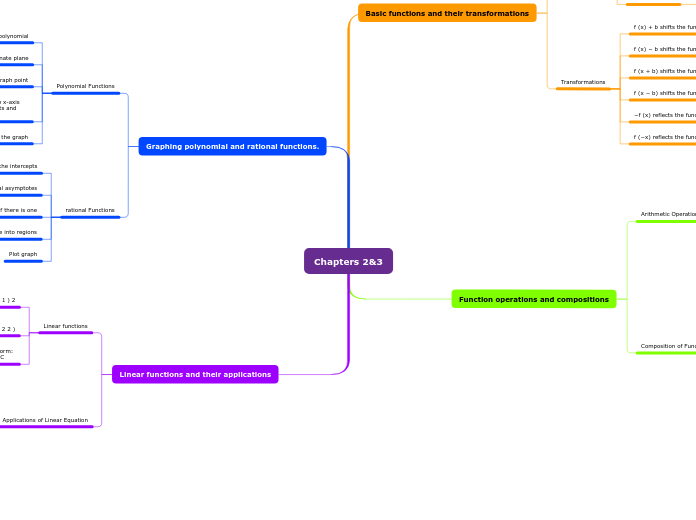Chapters 2&3
Basic functions and their transformations
Basic functions
Absolute Value Function
f(x)=|x|
Square Root Function
f(x)=√x
Cube Root function
f(x)=3√x
Identity Function
f(x)=x
Squaring Function
f(x)=x^2
Cubing Function
f(x)=x^3
Transformations
f (x) + b shifts the function b units upward
f (x) − b shifts the function b units downward
f (x + b) shifts the function b units to the left
f (x − b) shifts the function b units to the right
−f (x) reflects the function in the x-axis
f (−x) reflects the function in the y-axis
Function operations and compositions
Arithmetic Operations on Functions
Addition
(f+g)(x)
Subtraction
(f−g)(x)
Multiplication
(fg)(x)
Division
(f/g)(x)
Composition of Functions and Domain
Standard Function:
(f∘g)(x)=f(g(x))
Domain
Find the domain of g
Find the domain of f
You must find the inputs x within the domain of g for which g(x) is within the domain of f
Specifically, exclude any input x from the domain of g for which g(x) is not in the domain of f
The resulting set is the domain of f∘g
Graphing polynomial and rational functions.
Polynomial Functions
Find the zeros for the polynomial
Plot the x- and y-intercepts on the coordinate plane
Determine which way the ends of the graph point
Determine whether the graph lies above or below the x-axis by picking any value between consecutive x-intercepts and plugging it into the function
Plot the graph
rational Functions
Find the intercepts
Find the vertical asymptotes
Find the horizontal asymptote, if there is one
vertical asymptotes will divide the number line into regions
Plot graph
Linear functions and their applications
Linear functions
Distance equation:
d = ( x 2 − x 1 ) 2 + ( y 2 − y 1 ) 2
Midpoint Equation:
M = ( x 1 + x 2 2 , y 1 + y 2 2 )
Standard Form:
Ax + By = C
Applications of Linear Equation
Geometry Problems
Motion Problems
Mixture Problems
Application of linear equations
